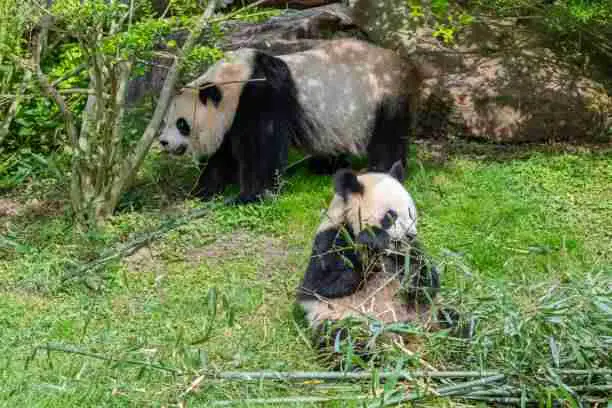A general fact about most mammals is that they breastfeed their child. In addition, producing the milk needed as food for young ones is a common thing that all kinds of mammals do. However, despite being placental mammals, pandas have certain behaviors that are still different which keeps me wondering; do giant pandas produce milk?
Yes, giant pandas produce milk. And just like other placental mammals, this milk always forms whenever a mother panda gives birth. The first milk it produces changes very slowly to mature milk unlike that of other placental mammals.
However, as this milk changes, the contents also change to meet the important needs and better development of the panda cub.
Now you know that giant pandas produce milk, you may also want to learn more about how panda young ones are cared for. However, pandas produce this milk in small amounts, and I wonder; do giant panda babies nurse?
Let’s dive deeper into this article to find out!
Do Giant Pandas Nurse Their Young?
Absolutely! Baby pandas nurse very well and for a long time. In fact, they have to feed on their mom’s breast milk for them to survive and grow well. More especially, the first milk, the colostrum, is the most important food they need at the early stages.
Unlike most placental mammals that are somewhat mature, panda babies appear blind, deaf, furless, and very small. Their mothers are normally about a thousand times bigger.
Moreover, these cubs are completely dependent on their moms for almost everything – protection, warmth, and mostly food. They can’t even defecate or urinate on their own. Their moms still help them do this.
Most research on captive pandas proved that anything aside from their mother’s milk can’t produce a healthy panda. This is why the colostrum is important to keep the weak cub immune to several diseases.
How Do Pandas Nurse Their Babies?
Panda moms are very protective of their babies after they give birth to them and will nurse them for months until they’re fit to care for themselves. As they say, parental care is high in mammals, these cute mammals are an example of such loving parents.
Interestingly, a mother panda wouldn’t leave sight of their newborn cub even for food. They feed their young ones with the breast milk they produce. Also, since the cubs can’t regulate their body heat themselves, panda moms help them do this.
Training and nursing more than one cub is hard for pandas to do. They are naturally lazy but this has more to do with the small amount of milk they produce. It won’t be enough to properly feed two.
This is why they select the stronger cub out of every twin they give birth to. It’s been proven that no one can nurse and train a panda cub the way panda moms do.
Moreover, pandas will allow their cubs to walk around when they know their fit to do it. As time goes on, they’ll teach them all they need to survive, especially in the wild.
How Long Do Baby Pandas Stay with their Mom?

Baby pandas stay with their mom for about a year or two and mostly when their moms get pregnant again. However, at about five months of age, they are already fit to care for themselves.
During these times, they learn to walk, climb, and eat solid food, especially their bamboo diet. Nevertheless, a six-month-old panda still needs its mom’s milk.
However, the case with pandas living in captivity is different. They don’t stay for long with their mothers like those in the wild. Captive panda cubs, about 3 – 5 months old are ready to be taken away from their moms.
This is a conservation method that helps create chances for mother pandas to give birth every year.
Final Thoughts
To sum up, giant pandas can produce milk. This breast milk is very important for their young ones. Despite how clumsy these creatures may be, they make great moms!
However, their first milk, colostrum, can’t be replaced and is very important for every panda development. Now you know that pandas aren’t quite clumsy when it comes to caring for their kids.
You’ll learn a lot about these cute creatures as you visit more of our blogs like this one.
If this article was helpful, do well to share it!

